Whatever You Need to Find Out About the UH 60 Helicopter
The UH-60 helicopter, a keystone of United state Army aeronautics because its launching in 1979, stands for an impressive blend of design and operational versatility. As armed forces requirements progress, so as well does the helicopter, with continuous innovations aimed at improving its abilities and integrating modern technologies.
History of the UH-60
Created in the late 1970s, the UH-60 Black Hawk helicopter became an action to the U.S. Army's demand for a versatile utility helicopter that might execute a selection of missions under difficult conditions. The inspiration for its design was the shortcomings recognized in the earlier helicopters utilized during the Vietnam War, especially in regards to rate, ability to move, and survivability.
The Black Hawk was developed by Sikorsky Airplane, integrating sophisticated technologies and materials to boost its performance and resilience. It was officially introduced into service in 1979, swiftly coming to be a critical asset for military operations - uh 60. Its capability to transport troops, clinical discharge, and logistical support in both combat and humanitarian missions made the Black Hawk a vital component of the united state Military's air travel fleet
Throughout the years, the UH-60 has actually been continually upgraded, adapting to the changing nature of warfare and the advancing requirements of contemporary army operations. Its functional background consists of participation in major conflicts, peacekeeping goals, and calamity relief initiatives, solidifying its track record as a reliable and reliable helicopter in numerous atmospheres worldwide.

Design and Specs
The style of the UH-60 Black Hawk helicopter constantly mirrors a commitment to functional performance and versatility. Established by Sikorsky Airplane, this medium-lift utility helicopter features a streamlined, aerodynamic body that improves speed and maneuverability. Its tandem blades system, characterized by two counter-rotating blades, lessens vibration and enhances lift ability, permitting safer procedures in varied atmospheres.
The UH-60 is powered by two T700-GE-701C turboshaft engines, providing an optimum speed of around 180 knots and a series of around 400 maritime miles. Its durable airframe is built from sophisticated composite products, making sure sturdiness while preserving a fairly low weight. The helicopter has an optimum gross weight of regarding 22,000 pounds, sustaining a versatile haul setup.

Roles and Objectives
A flexible system, the UH-60 Black Hawk helicopter offers a wide range of duties and objectives within military procedures. Designed primarily for troop transportation, it is qualified of carrying as much as 11 soldiers, making it a vital possession for fast implementation and logistical assistance.
Along with troop transportation, the UH-60 succeeds in clinical discharge (MEDEVAC) objectives, furnished with innovative medical equipment to provide important care throughout transportation. Its capability to operate in varied settings improves its effectiveness in combat search and rescue (CSAR) operations, where quick extraction of employees is crucial.
The helicopter additionally plays a significant role in reconnaissance and surveillance goals, using onboard sensing units and equipment to debrief. Its adaptability expands to logistical assistance, capable of transferring products and equipment to onward running bases.
In fight procedures, the UH-60 can be equipped with different weapon systems, allowing it to provide close air assistance. Its multi-role capability makes the Black Hawk a vital device for contemporary army pressures, adapting flawlessly to the evolving demands of field of battle situations and guaranteeing goal success throughout a variety of functional contexts.
Efficiency and Capabilities
Understood for its robust efficiency, the UH-60 Black Hawk helicopter flaunts impressive capacities that enhance its functional efficiency across numerous goals. uh 60. This multi-role airplane is outfitted with powerful twin-engine Turbomeca Arriel 1D1 engines, offering extraordinary rate and ability to go to website move, with a maximum cruise rate of approximately 150 knots and an operational variety of around 400 maritime click here to read miles
The Black Hawk's advanced avionics and fly-by-wire control systems significantly improve trip security and handling, allowing it to run in diverse settings, consisting of adverse climate conditions. Its adaptability is more exhibited by its capability to carry as much as 11 fully geared up troops or a payload of approximately 8,000 extra pounds, making it suitable for troop transport, medical emptying, and logistical assistance objectives.
Furthermore, the UH-60 is created for survivability, including strengthened airframes, ballistic protection for team and travelers, and advanced countermeasure systems to avert threats. The helicopter's agility and speed, combined with its capability for quick implementation, make it an indispensable property in contemporary army procedures, making sure that it stays a crucial element of tactical air support and battlefield flexibility.
Future Dope

One considerable focus is the combination of innovative avionics systems, which will improve situational understanding with improved navigating and interaction capacities. This includes the potential use of man-made intelligence to assist pilots in decision-making and objective preparation.
Furthermore, future variants might incorporate sophisticated materials and layout features to boost the helicopter's durability and minimize its radar trademark, enhancing survivability in contested environments.
The introduction of hybrid-electric propulsion systems is likewise coming up, intending to improve gas effectiveness and decrease logistical worries. Such advancements could expand operational range and decrease the helicopter's ecological footprint.

Conclusion
The UH-60 helicopter represents a significant innovation in armed forces aeronautics given that its intro in 1979. The UH-60's sustaining presence underscores its essential function in modern-day armed forces operations and highlights the recurring evolution of army air travel technology.
The UH-60 helicopter, a keystone of United state Military aviation considering that its debut in 1979, stands for a remarkable mix of design and functional convenience. As army requirements advance, so as well does the helicopter, with ongoing improvements intended at enhancing its abilities and integrating contemporary technologies.The layout of the UH-60 Black Hawk helicopter continually reflects a commitment to functional effectiveness and versatility. Established by Sikorsky Aircraft, this medium-lift energy helicopter includes a sleek, aerodynamic fuselage that boosts speed and maneuverability.The UH-60 helicopter stands for a significant development in army aeronautics considering that its intro in 1979.